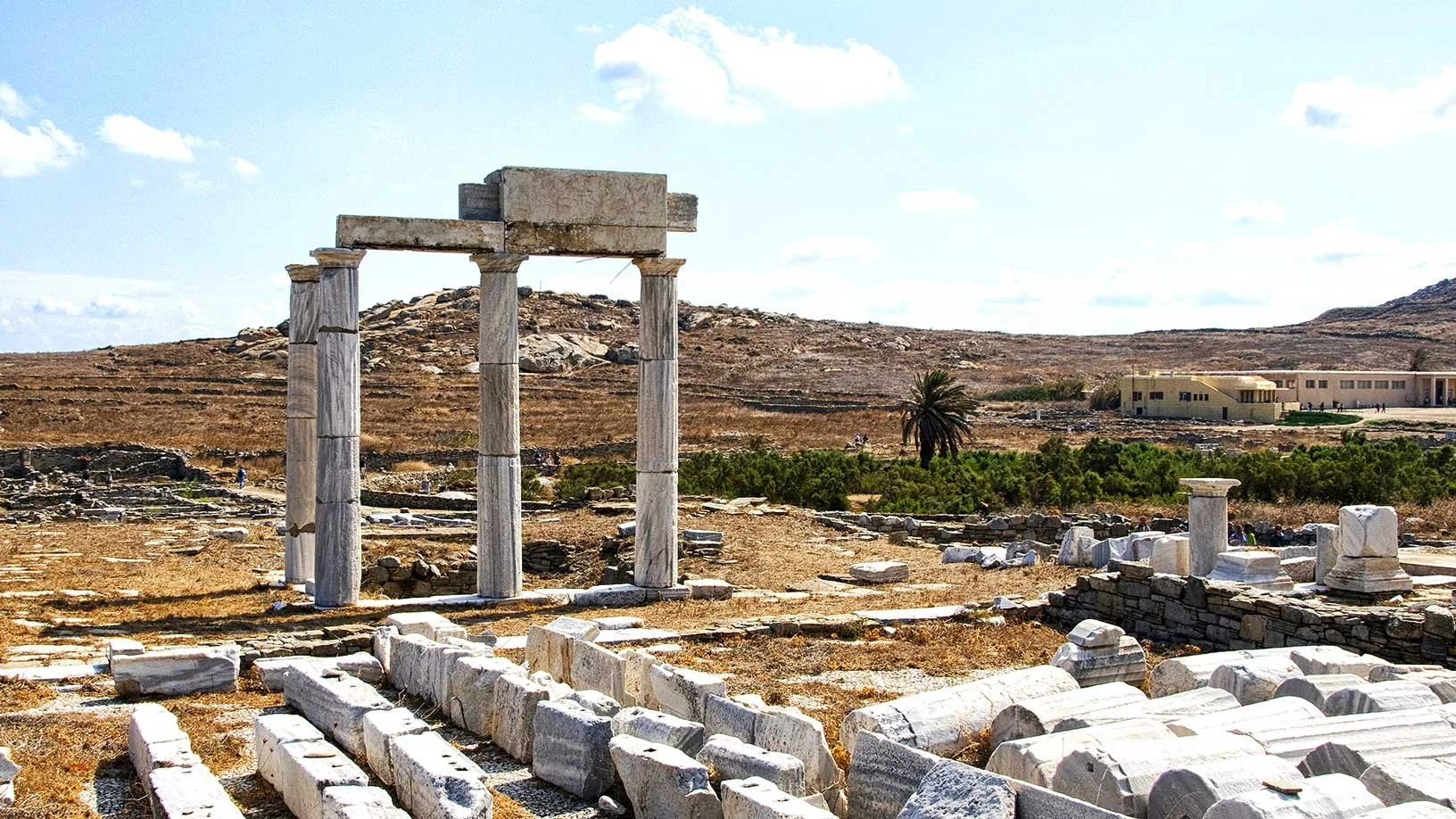Delos Island Unesco world Heritage site
Photo: In a slightly elevated position overlooking the sacred Lake and the Agora of the Italians you will find The Lions Terrace. (Originally nine marble lions)
Delos the sacred Island
was the leading spiritual centre of ancient Greece. Apollo and Artemis were born here, two of the most important Gods.
(In the Greek myth, Leto anther of Zeus lovers landed at Delos and gave birth to the twin immortal Apollo and his sister Artemis)
Ferry dock at Delos Port
My latest visits to Delos (2009 and again 2013) The tourboat arrived in the natural harbour. I was told we anchored at the ancient commercial harbour.
Delos is a small rocky island
5km long and less than 1.5km wide flat landscape and bare. Mount Kynthos 112m is the highest peak. Some small bays around the island. It is estimated that in the early time of the 1st century BC, up to 30,000 people was living here. Today an unhabituated island.
Delos first inhabitants
is likely to have build their homes on the top of the Kynthos Hill around 2.500 BC. The Kynthos Cave is mostly a man-made cave, roofed by large blocks of granite. The Cave is located near the summit of Kynthos Hill.
The excavations of Delos
started in 1872-73 by the French School in Athens and are still ongoing
The sanctuary of Apollo
From the harbour I followed the majestic sacred way to the sanctuary of Apollo. Three temples dated from the 5th and 6th century BC.
Sanctury of Apollo, to your right in the picture Delos Archaeological Museum
To your right in the picture Delos Archaeological Museum was built on-site in 1904 by the Archaeological Society of Athens
Its original five rooms was expanded in 1931 and in 1972 to nine rooms.
Delos Archaeological Museum
Delos Archaeological Museum was built on-site in 1904 by the Archaeological Society of Athens. Its original five rooms was expanded in 1931 and in 1972 to nine rooms.
Groups of Cycladic sculptures from the Archaic and Hellenistic (especially paintings) periods and objects of every day life and collection of vases from various periods. Renovated rcently and was officialy reopen again 2024.
Archaic Greece was the period in Greek history lasting from c. 800 BC to the second Persian invasion of Greece in 480 BC.
Source:Wikipedia
Hellenistic period covers the time in Mediterranean history after Classical Greece, between the death of Alexander the Great in 323 BC and the death of Cleopatra VII (30 BC),[1] followed by the emergence of the Roman Empire,
Source:Wikipedia
Photos from my visit to Delos Museum. An amphora is a specific type of antique vase, characterized by its two handles and narrow neck, typically used for storage. I have no idea who the serious looking man could be.
Delos Theatre
The ancient theatre of Delos
was compleated (marble) year 250BC. The theatre has the characteristic tripartite form of Hellenistic theatres: cavea, orchestra and stage building, and allegedly the ancient theatre had a capacity of between 5000-6000 spectators. I was impressed even if the ancient theatre was in ruin.
The ancient water cistern/reservoir
The ancient water cistern/reservoir on Delos,
particularly the one near the theater, what a remarkable example of Hellenistic water management. It is a large, underground structure built to collect and store rainwater, primarily from the theater's cavea (seating area).
The cistern's roof was supported by eight granite arches, and it could hold a significant amount of water, contributing to the island's water supply.
The cistern is large, with a depth of 8.3 meters and a capacity of 270 cubic meters. It is 22.5 meters long and 6 meters wide and it is believed it was built in the 3rd century BC.
Don’t Miss a day visit to Delos
Walk and follw the footsteps of the early settlers admire what they constructed and built for many centuries ago. No wonder that the ancient Delos was a bustling hub of commerce, religion, and culture during the Hellenistic period, with a diverse population of wealthy merchants, bankers, and ship-owners alongside laborers and slaves.
This UNESCO World Heritage site attract over 100.000 visitors a year, today, I wonder how many of them are wealthy merchants, bankers, shipowners, laborers and slaves.





